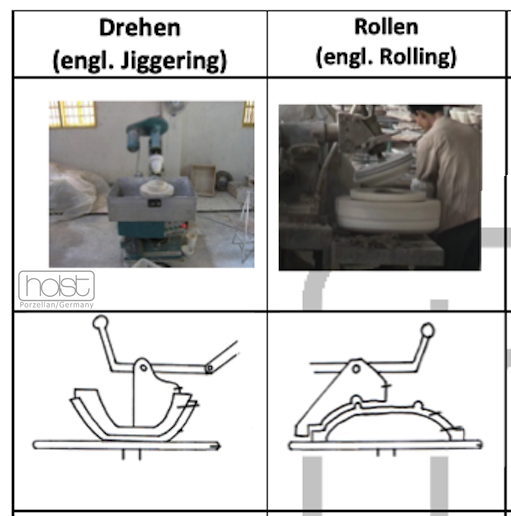Rolling
The rolling of flat parts in the porcelain industry
When differentiating between the production techniques "turning" and "rolling" of ceramic products, one often finds overlaps or confusion, as both types of process are operated with the help of rotation. A distinction is made between two methods:
- Over-rolling (Exterior), where the mass is rolled over a mould
- Inside-rolling (Interior), where the mass is rolled into a mould
A further contribution is made by the fact that in English both techniques are called "rolling", as there is no difference between "turning" and "rolling" in the choice of words. Both methods, exterior and interior, work with a solid mass, the "hubel", which is placed on or in the mould as a cut disc. A rotating stamp then distributes the mass evenly over or in the mould. After a short drying time of only a few minutes, the article can be removed from the mould.

In this section we look at traditional plate making. "Rolling" is the technical term for round flat parts such as plates and saucers. Basically, there are 3 traditional production methods for making such flat parts from ceramic materials:
- Rolling
- Pressing
- Isostatic pressing
Plate rolling describes the "exterior" production method in which the porcelain mass is "rolled out" on an underlying mould. In porcelain language, "plate rolling" is the shaping of flat parts with the help of rotation, usually by a rotating punch and an underlying mould. Only round or slightly oval flat parts can be produced on a plate roller. Here it becomes clear how the porcelain maker distinguishes between "plate" and "platter". In traditional porcelain production, plates were always rolled before the invention of isostatic plate presses. Contrary to the consumer, who calls a square plate a "square plate", the porcelain maker always calls the "square plate" a plate, because a plate - as a member of the family of flat parts - was always pressed. So remember: plate = round, platter = square or oval.
The semi-automatic disc roller
Semi-automatic machines come in many variations and arrangements. There are round cycle lines (from 6 to 48 units), straight-line semi-automatic machines (2 to 24 units) and any other arrangement of production units. However, all types of plate rollers work according to the same principle of "exterior" production. The porcelain mould at the bottom carries the shape or pattern (e.g. relief or festoon) as a negative and the upper punch rolls out the porcelain mass evenly on the mould. After a short drying time, the still mouldable mass (plate body) can be removed from the mould and used either for the first firing or for cleaning out (removing excess material). The production capacity of a single roller is considerable. We have measured outputs of up to 600 plates/hour on a single roller at our partner factories. The production halls that house roller lines can reach gigantic proportions. Our largest partner factory in Asia has a production floor - with single rollers only - of over 3,000 sqm.
Each of our production partners is regularly checked by our staff for compliance with our standards, because only a "clean" factory can produce good goods in the end! It is not the size of the factory that is decisive, but its organisational structure, the condition of the machines and equipment as well as a schematically organised quality management.
The social, human aspect is also taken into account when selecting our production partners. As a matter of principle, we do not have our porcelain produced in factories that are inhumane or that cause significant environmental problems. Bright lighting conditions and dust disposal are also important factors in porcelain production because otherwise the glazes cannot be applied in the desired purity. We can confidently assure our customers that our production partners produce according to the standards of Western European manufacturing methods!
The single-place roller
Single-place rollers work according to the same principle (exterior) as semi-automatic machines. The single station roller is so popular in porcelain production because it can be positioned variably and does not require any direct connection to other porcelain production stations. Many production companies make use of hall space that cannot be used for other purposes. Furthermore, single-position rollers help to break so-called "peaks", i.e. they are only used when required and when orders are available.
